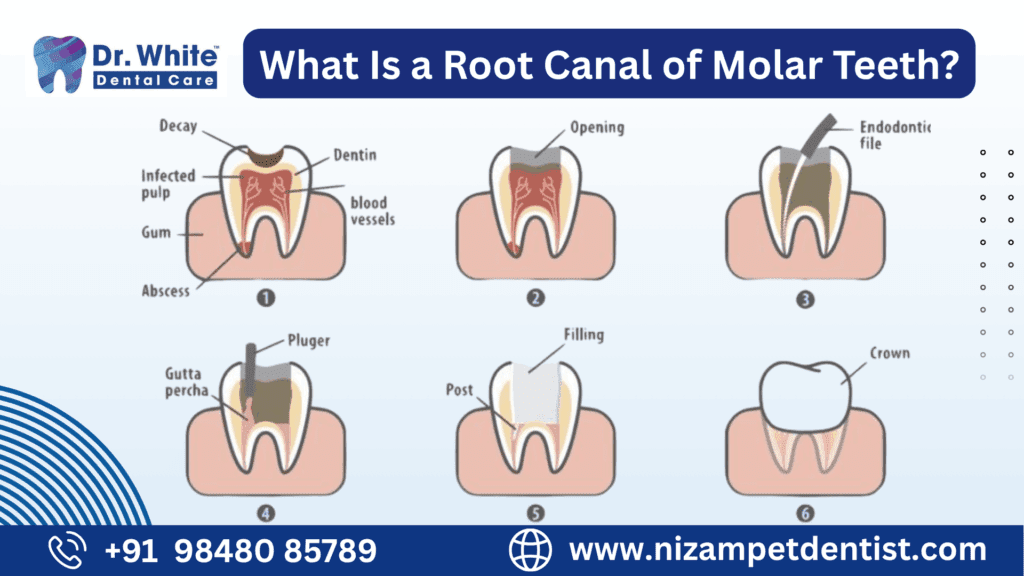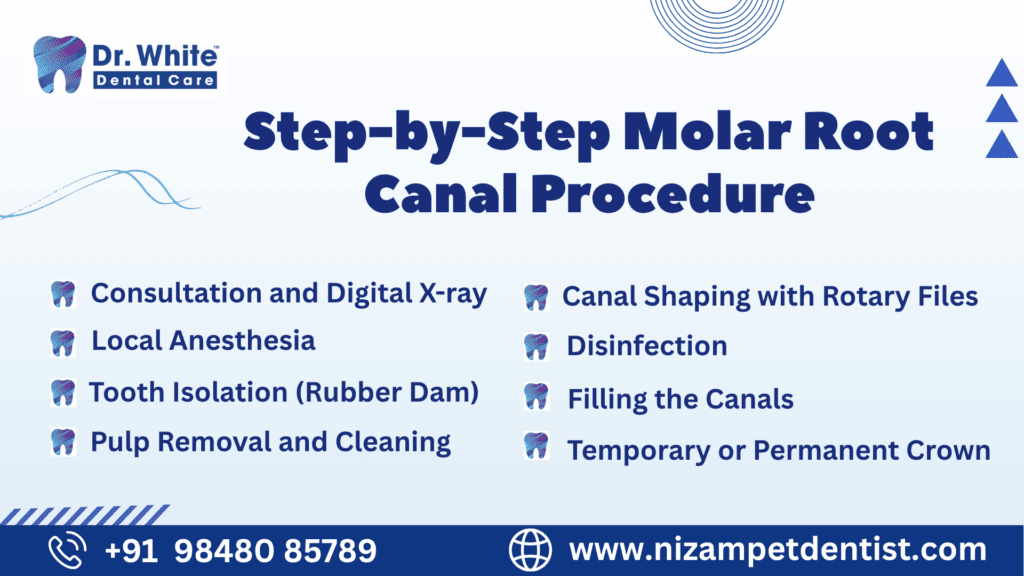Root Canal of Molar Teeth

Root canal treatment of molar teeth is done to save badly infected or painful back teeth. Molars are important for chewing and have multiple roots, which makes the procedure more detailed. During treatment, the dentist removes the infected pulp, cleans all the canals, and seals the tooth to stop further damage. Thanks to modern techniques, the procedure is safe and mostly painless. It helps keep your natural tooth in place and avoids the need for removal. If you have tooth pain or swelling, a molar root canal may be the right solution to protect your oral health.
What Is a Molar Root Canal?
- A root canal is done to save a molar tooth that’s infected or badly decayed.
- The dentist removes damaged nerves and pulp from inside the tooth.
- The empty space is cleaned and filled with a safe material.
- This stops pain and infection while keeping the natural tooth in place.
- It’s a common, safe treatment that helps you avoid tooth removal.
Why Molars Are Different
- Molars are large, flat teeth at the back of your mouth used for chewing.
- They usually have 2 to 4 roots, unlike front teeth which have only one.
- This makes treatment more complex and time-consuming.
- Molars face more pressure, wear, and are prone to deep decay or cracks.
- They often need specialized care by an experienced dentist or endodontist.
Who Needs This Treatment
- You may need a molar root canal if you have:
- A deep cavity
- Tooth pain while chewing
- Sensitivity to hot or cold
- Swelling or a small bump on the gums
- It’s also needed if a molar is cracked or injured.
- Without treatment, infection may spread and cause tooth loss.
- Root canals save your natural tooth and stop infection from getting worse.
- People with healthy gums and general health are usually good candidates.
Promise of Painless, Modern Procedures
- Today’s root canals are safe, fast, and nearly pain-free.
- Dentists use digital X-rays, modern tools, and strong numbing medication.
- You may feel pressure but not sharp pain during the procedure.
- Sedation options are available if you are anxious or nervous.
- Most treatments are done in 1–2 visits.
- Mild soreness after treatment is common but goes away quickly.
- You can return to normal activities within a day or two.
What Is a Root Canal of Molar Teeth?

A root canal of molar teeth is a dental procedure used to treat infection or damage inside your back teeth—called molars. These teeth are important for chewing and have more roots than front teeth, which makes them harder to treat. In a root canal, the dentist removes the infected pulp, cleans the inside of the tooth, and seals it to prevent further problems. This helps you save your natural tooth instead of removing it and keeps your bite strong and healthy.
Simple Explanation
Tooth Anatomy: What Makes Molars Different
- Molars are bigger and have 2 to 4 roots, unlike front teeth that have just one.
- Their complex structure makes cleaning and sealing more challenging.
- This is why molar root canals require more time and skill.
Importance of Saving Natural Teeth
- Your natural teeth are stronger than any artificial replacement.
- Saving a molar maintains your bite and jawbone strength.
- It also avoids shifting of nearby teeth and chewing issues.
Benefits Over Tooth Extraction
- A root canal keeps your natural tooth in place—extractions leave a gap.
- It avoids the need for costly tooth replacements like implants or bridges.
- Recovery from a root canal is often quicker than from an extraction and implant.
Signs You May Need a Molar Root Canal
A molar root canal is often needed when the nerve inside your back tooth becomes infected or damaged. These problems don’t always cause sharp pain at first, but there are several clear signs to watch for. If you notice any of the symptoms below, it’s important to visit a dentist as soon as possible. Early treatment can help save your natural tooth and prevent the infection from spreading.
Signs You Might Need a Molar Root Canal
- Deep, Lasting Toothache
A strong, throbbing pain in the back tooth that doesn’t go away could mean the nerve is infected. - Pain While Chewing
Sharp or dull pain when biting or chewing is a common sign of a tooth with nerve damage or infection. - Sensitivity to Hot and Cold
If you feel discomfort that lingers when eating or drinking something hot or cold, it may be a sign of nerve trouble inside the molar. - Swelling or Pus Around the Gums
Swollen gums, a small bump (abscess), or pus near a molar tooth are signs of infection that often require a root canal. - Tooth Discoloration
A darkened or grey-colored molar could indicate that the nerve inside the tooth is no longer alive and may be infected. - Crack or Trauma to Molar
A chipped, cracked, or injured molar can expose the nerve to bacteria and lead to infection that requires root canal treatment.
Step-by-Step Molar Root Canal Procedure

A molar root canal is a common dental treatment that helps save your natural back tooth when it becomes infected or badly decayed. Though many people fear it, the procedure is safe, modern, and usually painless. It involves cleaning out the damaged inner part of the tooth and sealing it to stop pain and prevent further infection. Understanding each step of the process can reduce anxiety and help you feel more confident before treatment.
1. Consultation and Digital X-ray
- What it means: Your dentist will first ask about your pain and symptoms.
- Purpose: A digital X-ray is taken to view the inside of the tooth, detect infection, and check how many roots the molar has.
2. Local Anesthesia
- What it means: A numbing injection is given near the tooth.
- Purpose: This ensures you feel no pain during the entire treatment.
3. Tooth Isolation (Rubber Dam)
- What it means: A small rubber sheet is placed around the tooth.
- Purpose: It keeps the tooth dry and prevents saliva from entering while cleaning the tooth.
4. Pulp Removal and Cleaning
- What it means: The infected or dead pulp (nerve tissue) inside the tooth is taken out.
- Purpose: Removing the infected part helps stop pain and infection from spreading.
5. Canal Shaping with Rotary Files
- What it means: Tiny electric tools are used to shape and widen the tooth’s root canals.
- Purpose: This step prepares the canals so they can be properly cleaned and filled.
6. Disinfection
- What it means: A liquid solution is used to rinse the inside of the canals.
- Purpose: It kills any remaining bacteria and keeps the inside of the tooth clean.
7. Filling the Canals
- What it means: The canals are filled with a rubber-like material called gutta-percha.
- Purpose: This seals the tooth from inside and prevents future infections.
8. Temporary or Permanent Crown
- What it means: A temporary cap or a permanent crown is placed over the molar.
- Purpose: It protects the treated tooth and restores its shape, strength, and function for chewing.
Is Molar Root Canal Painful?
One of the biggest fears people have about a molar root canal is pain. The good news is that modern dental technology has made the procedure almost painless. Most patients say that the discomfort they feel before the treatment—due to infection or inflammation—is actually worse than the root canal itself. Dentists use strong local anesthesia and advanced tools to make sure you stay comfortable. After the procedure, you may feel a little soreness, but it usually goes away in a few days with mild medication. Knowing what to expect can ease your anxiety.
1. Pain During Procedure (Minimal)
- The actual root canal treatment is usually not painful.
- You may feel slight pressure, but no sharp pain.
- Advanced techniques and tools help make the experience smooth and easy.
2. Pain After Treatment
- Some soreness or tenderness is normal for a few days.
- This is due to the healing of tissues around the treated tooth.
- Over-the-counter pain relievers are usually enough to manage it.
3. Local Anesthesia + Sedation Dentistry
- Local anesthesia is used to completely numb the area before treatment.
- You stay awake, but you won’t feel any pain.
- Sedation dentistry (optional) helps if you have dental anxiety. It keeps you relaxed and calm during the procedure.
4. Post-op Discomfort: What to Expect
- You may feel mild throbbing or pressure for 1–3 days.
- Avoid chewing on that side until the pain goes away.
- If pain lasts longer than a week, see your dentist for a follow-up.
How Long Does a Molar Root Canal Take?
A molar root canal typically takes longer than one done on a front tooth due to the complexity of its roots. Most treatments are completed in one or two visits, depending on the severity of the infection and the dentist’s approach. After the root canal, a dental crown is usually placed to protect the tooth, which might require a separate visit. Healing time varies for each person, but the full process—from cleaning to crown placement—can take a few days to a few weeks. Knowing the timeline helps in planning your schedule and follow-ups.
1. One Visit vs Two Visits
- Single-visit root canals are possible if the infection is mild and the tooth is easy to clean.
- Two visits are more common for molars because they have multiple roots and require more care.
- In the first visit, the tooth is cleaned and sealed; the second visit focuses on the permanent crown.
2. Crown Placement Timing
- After the root canal, a crown is placed to protect the tooth from breaking.
- It can be placed immediately (same day) if your clinic offers same-day crowns.
- Otherwise, it’s done in 7–10 days, once the lab prepares the custom crown.
3. Time for Healing and Crown Fitting
- Mild soreness is normal for 2–3 days after the root canal.
- Your tooth needs time to settle before final crown placement.
- Full healing and comfort typically occur within 1–2 weeks after the final crown is placed.
Root Canal of Molar Teeth vs Extraction
When a molar is damaged or infected, the two main options are root canal treatment or tooth extraction. A root canal helps you keep your natural tooth by removing the infection and sealing the inside. Extraction removes the tooth completely and may need follow-up treatment like a dental implant. While extraction may seem quicker, it can cause long-term issues like teeth shifting or bone loss. Root canal treatment is usually preferred for better long-term oral health, function, and appearance.
1. Long-term Oral Health
- Saving your natural tooth keeps your bite balanced.
- Prevents bone loss in the jaw.
- Supports better chewing and overall mouth structure.
2. Cost Comparison
- A root canal with a crown may cost more upfront than extraction.
- But extraction often leads to extra costs (implants, bridges).
- Over time, root canal is more cost-effective when saving a molar.
3. Prevent Shifting of Nearby Teeth
- Losing a molar creates a gap.
- Nearby teeth may shift into the empty space, causing misalignment.
- A root canal keeps the tooth in place and supports overall dental stability.
4. Implant Requirement if Extracted
- After extraction, you’ll likely need a dental implant to replace the missing tooth.
- Implants are effective but more costly and take longer to heal.
- Root canals avoid the need for this additional procedure.
Molar Root Canal Cost in India
The cost of a molar root canal in India, especially in cities like Hyderabad, can vary based on the complexity of the case and the type of crown used. Since molars have more roots and are harder to treat than front teeth, their treatment is usually more expensive. Advanced technology, experienced specialists, and the material used for the crown also affect the price. Still, root canals are more affordable in India compared to many countries, and clinics offer EMI and insurance options to help make the treatment budget-friendly.
1. Average Cost in Metro vs Towns
- In metros like Hyderabad, the cost for a molar root canal ranges from ₹4,000 to ₹12,000.
- In smaller towns or non-metro areas, it may be slightly lower—around ₹3,000 to ₹8,000.
- Premium clinics in metros may charge more due to advanced technology and expert care.
2. Factors That Affect Cost
- Tooth Complexity: Molars have more canals, which require extra time and expertise.
- Crown Type: Ceramic or zirconia crowns cost more than metal or PFM crowns.
- Technology Used: Use of digital X-rays, rotary tools, or microscopes increases the cost but ensures better results.
3. Cost Comparison: Front vs Molar
- Front teeth root canals usually cost less because they have fewer canals and are easier to treat.
- Molars require more effort, materials, and time, making them slightly more expensive.
4. EMI / Insurance / Payment Plans
- Many clinics in Hyderabad offer EMI options (monthly payment plans) for expensive treatments.
- Dental insurance may cover part of the root canal cost—check with your provider.
- Ask about clinic discounts or packages, especially if you also need a crown or multiple treatments.
What to Expect After the Procedure (Recovery & Aftercare)
After a molar root canal, proper recovery and aftercare are very important for healing and long-term success. While the pain is usually minimal after the treatment, you may feel slight soreness or pressure for a few days. Following your dentist’s instructions will help reduce discomfort and protect the treated tooth. Eating soft foods, keeping your mouth clean, and avoiding pressure on the tooth during the first week will support a faster and smoother recovery.
1. What to Eat (Soft Foods)
- Stick to soft and cool foods like curd, dal rice, mashed potatoes, bananas, idli, and upma.
- Avoid hard, sticky, or spicy foods for at least 3–5 days.
- Chew on the opposite side of the treated tooth to prevent pressure and pain.
2. Pain Management
- Slight pain or discomfort is normal after the numbness wears off.
- Use over-the-counter painkillers (like paracetamol or ibuprofen) as recommended by your dentist.
- If the pain increases or doesn’t reduce in 2–3 days, contact your dental clinic.
3. Oral Hygiene Tips
- Keep brushing your teeth gently twice a day with a soft-bristled toothbrush.
- Rinse your mouth with lukewarm salt water to reduce swelling and prevent infection.
- Avoid brushing too hard near the treated molar until it heals completely.
4. Do’s and Don’ts for First Week
- Do: Eat soft foods, take medicines on time, maintain oral hygiene.
- Don’t: Smoke, chew hard foods, skip brushing, or put pressure on the treated tooth.
- Avoid very hot or cold drinks during the initial healing period.
How Long Does a Root Canal Last on a Molar?
A root canal on a molar can last anywhere from 10 to 20 years or even longer when properly done and well maintained. Molars are your main chewing teeth, so they experience more pressure and wear. That’s why after a root canal, placing a crown and following good oral hygiene is essential. While the treated tooth no longer has nerves, it still needs protection to avoid cracking or infection. With regular care and checkups, you can keep the tooth healthy for many years.
1. 10 to 20 Years with Good Care
- The life of a molar root canal can range between 10 to 20 years, depending on oral hygiene and lifestyle habits.
- Brushing twice a day, flossing, and regular den
2. Importance of Crown
- A dental crown covers the treated molar, protecting it from cracks, wear, and food pressure.
- Without a crown, the tooth can break easily, especially since molars handle most of the chewing.
3. Avoiding Re-infection
- Bacteria can still re-enter the tooth if the filling or crown is damaged.
- Avoid sticky foods, brush and rinse well, and get prompt dental care if the crown feels loose.
4. Night Grinding Precautions
- If you grind your teeth while sleeping (a condition called bruxism), it can damage the crown or tooth.
- Use a night guard if your dentist recommends one to prevent pressure and protect the treated molar.
Patient Before/After Results
We are here
Enquire Now
Error: Contact form not found.
FAQ'S
- Yes, root canals are safe for patients with well-controlled diabetes
- Your dentist will assess your overall health and healing ability first
- With proper care, diabetics can expect outcomes similar to non-diabetics
- Technically yes—the nerve inside the tooth is removed, so the tooth no longer “feels” temperature
- But the tooth remains functional and anchored in your jaw thanks to the periodontal ligament
- You’ll still feel pressure or biting force through this ligament
- Very common—root canals are a routine treatment for tooth infections and decay
- Molars are treated more frequently because they are used heavily and prone to infection
- Dentists perform hundreds of these treatments every year
